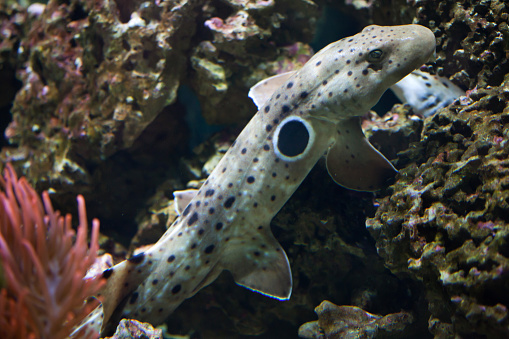ANIMAL: Epaulette Shark Hemiscyllium ocellatum Type of Animal: Carpet Shark Habitat: Reefs, tidal pools, coral flats, staghorn coral stands, sea floor, coastal waters, shallow inshore waters, small coral outcrops, not found deeper than 164 ft Location(s): W, N, & E coast of Australia, New Guinea coast, & coastal areas of Malaysia, Indonesia & Solomon Islands Appearance: Elongated body, short rounded snout, elevated oval eyes w/ a large spiracle below each eye, 5 pairs of small gill slits, slender caudal peduncle behind dorsal/anal fins where caudal fin attaches to body, broad rounded thickly muscled pectoral/pelvic fins, 2 similar sized dorsal fins, low anal fin just in front of caudal fin, adults beige to brownish above w/ widely spaced brown spots/subtle darker bands-very large black spot ringed in white behind each pectoral fin (epaulettes), juveniles have alternating light/dark bands over body/fins, dark band on tail Food/Diet: Crustaceans, worms, small bony fish Status in Wild: Stable Conservation: Breeding in aquariums, marine parks, & zoos Lifestyle: Solitary Additional Info: Called: Male Female Young: Pup Group: Solitary Weight: Male: 6 lbs Female: 7 lbs Gestation: 4 months Life Span: 20-25 years Body Length: Male: 1.9 ft Female: 2.1 ft Young: 8.3 in Tail Length: Male: 11.4 in Female: 12.6 in Young: 4.15 in Main predators are other sharks & groupers. They’re oviparous, laying eggs. Each egg case has 1-2 eggs. Females can produce up to 50 egg cases a year. Usually nocturnal or crepuscular. Sexually mature at 7 years old. During courtship, male often grasps female’s pectoral fin/gill area w/ mouth. Females sometimes initiate by following/biting male. Epaulette may act as eyespot for distracting/deterring predators. Relies mostly on olfactory & electroreceptive senses to locate hidden prey. Can suck prey into mouth by expanding muscular buccal cavity. Teeth can be depressed to form flat surface for crushing hard-shelled prey. Fun Fact(s): Parthenogenesis (virgin birth) documented on rare occasions & females can store male sperm for up to 3 years. If one were to want a pet shark, this species may be best option. However, they’re not for novice owners. These & other members of genus Hemiscyllium also called walking sharks, having been seen using pectoral/pelvic fins to walk on land/exposed areas when needed & using them to “walk” along sea floor in undulating crawling motion. Have ability to turn off/slow enough body functions to survive 3-6 hours w/ none to very little oxygen. They can slow heart rate/breathing & gradually limit blood flow to brain. These sharks are quite docile & easily approached.
